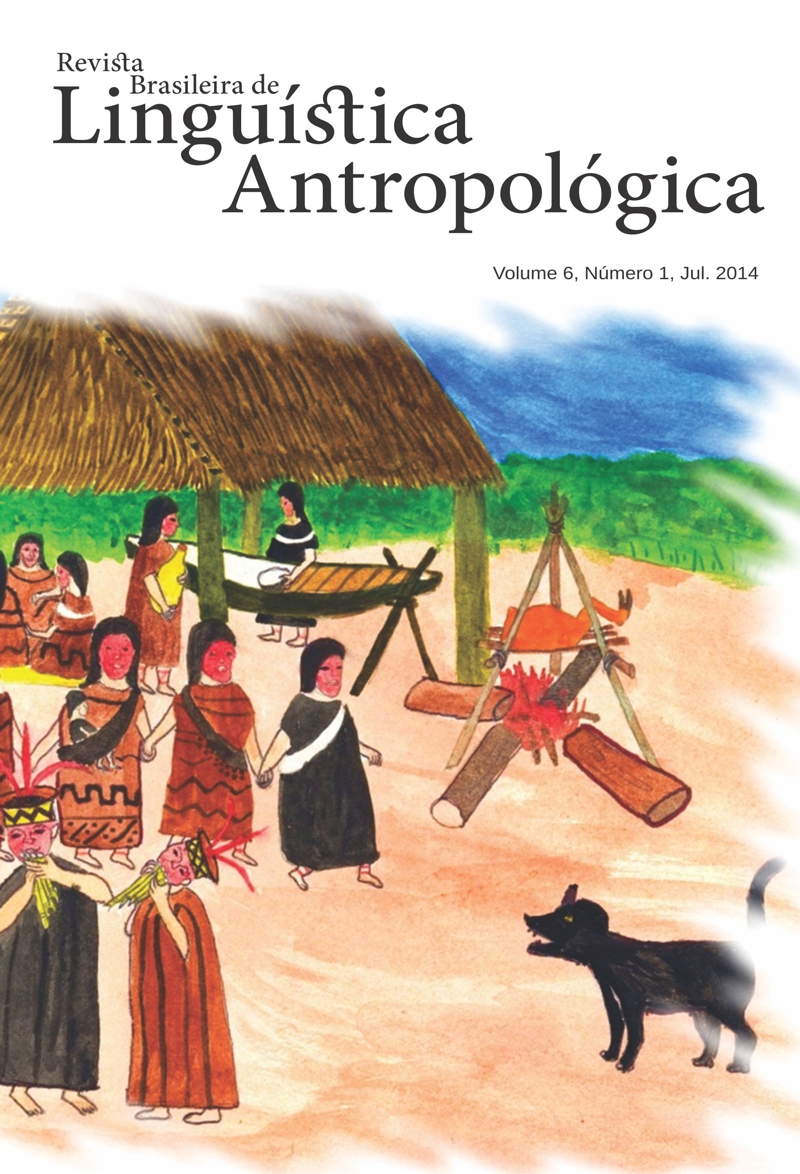Subject-Verb indexing strategies in Tukanoan languages: the codification and categorization of nominal referents on verbs
DOI:
https://doi.org/10.26512/rbla.v6i1.21065Keywords:
Nominal Classification. Number. Person. Indexation. Tukanoan languages.Abstract
This paper is about the systems of indexation of subject arguments on verbs in languages from the Tukanoan Family. It is concerned with how the categories of nominal classification, person and number interact in these systems, as well as with the syntactic status of indexing morphemes as markers of agreement, correference and/or verb arguments. Tukanoan lanmguages have a rich verb morphology, which also code several modal, evidential, temporal and aspectual categories, as well as clause types (declaratives, interrogatives and imperatives). The analyses focus on the typology of nominal classification, person and number, and provides discussion of relevant functional-pragmatic issues.
Downloads
References
Aikhenvald, Alexandra Y. Classifiers. A typology of noun categorization devices. Oxford: Oxford University Press, 2000.
Ariel, Mira. 1990. Accessing Noun Phrase Antecedents. London: Croom Helm.
Barnes, Janet. 1984. Evidentials in the Tuyuca verb. IJAL 50.255-271.
Barnes, Janet & Terrell Malone. 2000. El Tuyuca. In María Stella González de Pérez & María Luisa Rodríguez Montes (eds.), Lenguas indígenas de Colombia: Una vision descriptive. 437-452. Santafé d
Chacon, Thiago Costa. 2014. A revised proposal of proto-tukanoan consonants and tukanoan family classification. IJAL, vol. 80, no. 3, pp. 275”“322.
Chacon, Thiago Costa. 2012. The phonology and morphology of Kubeo: The documentation, theory and description of an Amazonian language. Ph.D. dissertation, University of Hawai’i.
Chacon, Thiago Costa. 2007. O sistema de classificação nominal do Tukáno. Revista de Estudos e Pesquisa. IV. Brasília: Funai.
Corbett, Greville. 2000. Number. Cambridge: Cambridge University Press.
Corbett, Greville. 2006. Agreement. Cambridge: Cambridge University Press.
Croft, W. 2013. Agreement as anaphora, anaphora as coreference. Languages across boundaries: studies in memory of Anna Siewierska, ed. Dik Bakker and Martin Haspelmath, 107-29. Berlin: De Gruyter Mouton.
Cook, Dorothy M. and Linda L. Criswell. 1993. El idioma koreguaje (tucano occidental). Bogotá: Asociación Instituto Lingüístico de Verano.
Gomez-Imbert, Elsa. 1982. De la forme et du sens dans la classification nominale en tatuyo (langue Tukano Orientale d’Amazonie Colombienne), Doctorat de 3e cycle. Paris: U. Paris-Sorbonne (=TDM 19, Editions ORSTOM, 1986), downloadable in www.ird.fr.
Gomez-Imbert, Elsa. 2007. Nominal classification in Tukanoan languages. In W. Leo Wetzels (ed.) Language Endangerment and Endangered Languages: Linguistic and Anthropological Studies with Special Emphasis on the Languages and Cultures of the Andean-Amazonian Border Area. Indigenous Languages of Latin America series (ILLA). Publications of the Research School of Asian, African and Amerindian Studies (CNWS). The Netherlands: Leiden University.
Gomez-Imbert, Elsa. 2004. Fonología de dos idiomas Tukano orientales. Amerindia. Vol. 29. Paris: CELIA.
Gomez-Imbert, Elsa. 2000. Como si tú y el agua fuesen una misma persona gramatical. Hein van der Voort & Simon van de Kerke (eds.), Indigenous Languages of Lowland South America [Indigenous Languages of Latin America, 1], p. 129-148. Leiden: Research School of Asian, African, and Amerindian Studies (CNWS).
Simon van de Kerke. 2011. La famille tukano. Dictionnaire des langues du monde, pp. 1454-60. Paris: Presses Universitaires de France.
Greenberg, Joseph. 1963 [1966]. Some Universals of Grammar with particular reference to the Order of Elements. Universals of language, ed. Joseph H.
Greenberg. 2nd edition. Cambridge, Massachusetts: MIT.
Grinevald, Colette. 2000. A morphosyntactic typology of classifiers, in: Gunter Senft (ed.), Systems of nominal classification. pp. 50-92. Cambridge: Cambridge University Press, 2000.
Grinevald, Colette & Seifart, Frank. 2004. Noun Classes in African and Amazonian languages: Towards a comparison. Linguistic Typology 8.243-285.
Haspelmath, M. 2013. Argument indexing: a conceptual framework for the syntax of bound person forms. In: Bakker, Dik & Haspelmath, Martin (eds.) 2013. Languages across boundaries: Studies in memory of Anna Siewierska, 197-226. Berlin: De Gruyter Mouton.
Malone, Terrell. 1988. The origin and development of Tuyuca evidentials. IJAL 54/2: 119-140.
Mason, J. A. 1950. The languages of South American Indians. Bureau of American Ethnology Bulletin 143:157”“317.
Miller, Marion. 1999. Desano grammar: Studies in the languages of Colombia 6. Summer Institute of Linguistics and the University of Texas at Arlington Publications in Linguistics, 132. Dallas: Summer Institute of Linguistics and the University of Texas at Arlington. xi.
Morse, Nancy L. & Michael B. Maxwell. 1999a. Cubeo Grammar. (Studies in the Languages of Colombia, 5; SIL Publications in Linguistics, 130.) Arlington: SIL and University of Texas Arlington Press.
Ramirez, Henri. 1997. A fala Tukáno dos Ye’pa Masa: Gramática. Tomo I. 1 ed. Manaus: CEDEM.
Senft, Gunter (ed.). Systems of nominal classification. Cambridge: Cambridge University Press, 2000.
Siewierska, Anna. 2004. Person. Cambridge: CUP.
Silva, Wilson. 2012. A Reference grammar of Desano. PhD dissertation. University of Utah.
Skilton, Amalia. 2013. A new proposal of Western Tukanoan consonants and internal classification. Senior Thesis Essay. Yale University.
Stenzel, Kristine. 2013. A Reference Grammar of Kotiria (Wanano). Lincoln: University of Nebraska Press.
Strom, Clay. 1992. Retuarã Syntax: Studies in the Language of Colombia 3. Arlington: Summer Institute of Linguistics/University of Texas, 1992.
Wheeler, Alva. 1987. El pueblo siona del río Putumayo, Colombia. Vol. 1: Etnología, gramática, textos. Bogotá: Instituto Linguistico de Verano.
Downloads
Published
How to Cite
Issue
Section
License

This work is licensed under a Creative Commons Attribution 4.0 International License.
Authors who publish in RBLA agree to the following terms:
a) Authors maintain the copyright and grant the journal the right of first publication, and the work is simultaneously licensed under the Creative Commons Attribution License, which allows the sharing of the work with recognition of the authorship of the work and initial publication in this journal.
b) Authors are authorized to assume additional contracts separately, for non-exclusive distribution of the version of the work published in this journal (eg, publish in an institutional repository or as a book chapter), with recognition of authorship and initial publication in this journal.
c) Authors are allowed and encouraged to publish their work online (eg, in institutional repositories or on their personal page) at any point before or during the editorial process, as this can generate productive changes, as well as increase impact and citation of the published work.







